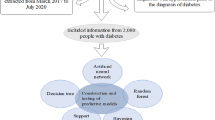Abstract
This study was to develop an objective method to stratify cardiovascular risk in hypertension. Stratification for cardiovascular risk is crucial in deciding treatment strategy for hypertension but has yielded undesirable results in clinic due to its low accuracy which is caused by physicians’ subjective experience and the uncertainty of patients’ statements. Our model proposed herein overcomes these disadvantages by applying artificial neural network based on a classic back propagation net. The model input is derived from the clinical investigation. The target output is the stratification level of total cardiovascular risk, which is learned from the guidelines of hypertension treatment. Study in 348 normotensive and hypertensive subjects showed that the results of model stratification are consistent with the standard stratification suggested by hypertension guidelines in 81.61% cases. The results confirm the accuracy of the model and demonstrate its ability in risk evaluation for hypertension.





Similar content being viewed by others
References
Ashizawa K, MacMahon H, Ishida T, et al. (1999) Effect of an artificial neural network on radiologists performance in the differential diagnosis of interstitial lung disease using chest radiographs. AJR Am J Roentgenol 172(5):1311–1315
Bidiwala S, Pittman T (2004) Neural network classification of pediatric posterior fossa tumors using clinical and imaging data. Pediatr Neurosurg 40(1):8–15
Blacher J, Asmar R, Djane S et al (1999) Aortic pulse wave velocity as a marker of cardiovascular risk in hypertensive patients. Hypertension 33:1111–1117
Chalmers J, MacMahon S, Mancia G et al (1999) 1999 World Health Organization-International Society of Hypertension Guidelines for the management of hypertension. J Hypertens 17:151–183
Chobanian AV, Bakris GL, Black HR et al (2003) The Seventh Report of the Joint National Committee on Prevention, Detection, Evaluation, and Treatment of High Blood Pressure: the JNC 7 report. NIH Publication
Gasowski J, Fagard RH, Staessen JA et al (2002) Pulsatile blood pressure component as predictor of mortality in hypertension: a meta-analysis of clinical trial control groups. J Hypertens 20(1):145–151
Girerd X, Giral P (2004) Risk stratification for the prevention of cardiovascular complications of hypertension. Curr Med Res Opin 20(7):1137–1142
Jolliffe IT (2002) Principal component analysis. Springer, Berlin, Heidelberg, New York, pp 1–6
Kannel WB (2000) Fifty years of Framingham study contributions to understanding hypertension. J Hum Hypertens 14:83–90
Lapuerta P, Azen SP, LaBree L (1995) Use of neural networks in predicting the risk of coronary artery diease. Comp Biomed Res 28:38–52
Lawrence S, Giles CL, Tsoi AC (1997) Lessons in neural network training: overfitting may be harder than expected. In: Proceedings of the fourteenth national conference on artificial intelligence, California, pp 540–545
Mancia G, Rosei EA, Cifkova R et al (2003) 2003 European Society of Hypertension—European Society of Cardiology guidelines for the management of arterial hypertension. J Hypertens 21:1011–1053
Mangiameli P, West D, Rampal R (2004) Model selection for medical diagnosis decision support systems. Decision Support Syst 36(3):247–259
Martin TH, Howard BD, Mark B (2002) Neural network design. China Machine Press, Beijing, pp 11.1–12.47
Ministry of Health People’s Republic of China, China Hypertension League, Drafting Committee for The Guidelines (1999) Guidelines for the management of hypertension of China (in Chinese)
Orunesu E, Bagnasco M, Salmaso C et al (2004) Use of an artificial neural network to predict Graves’ disease outcome within 2 years of drug withdrawal. Eur J Clin Invest 34(3):210–217
Poli R, Cagnoni S, Livi R et al (1991) A neural network expert system for diagnosing and treating hypertension. Computer 24(3):64–71
Schillaci G, Verdecchia P, Porcellati C et al (2000) Continuous relation between left ventricular mass and cardiovascular risk in essential hypertension. Hypertension 35:580–586
Sheps SG, Black HR, Cohen JD et al (1997) The sixth report of the joint national committee on prevention, detection, evaluation and treatment of high blood pressure: the JNC 6 report. NIH Publication
Verdecchia P, Schillaci G, Reboldi G et al (2000) Relation between serum uric acid and risk of cardiovascular disease in essential hypertension. Hypertension 36:1072–1078
Verdecchia P, Angeli F, Reboldi G et al (2003) Improved cardiovascular risk stratification by a simple ECG index in hypertension. AJH 16:646–652
Wang WH, Zhao D, Zeng ZC et al (2003) A cross-sectional study on knowledge and the ability of hypertension treatment among physicians in district and community hospitals (in Chinese). Chin J Epidemiol 24(12):1086–1089
Wu YF, Wang ZW, Gao RL (2004) A survey on perception and knowledge of Chinese health care professionals in prevention and control of hypertension (in Chinese). Chin J Cardiol 32(3):264–269
Acknowledgements
This work was partially supported by National Nature Science Foundation of China (30570483), and Science & Technology Department of Zhejiang Province, China (2004C33033).
Author information
Authors and Affiliations
Corresponding author
Rights and permissions
About this article
Cite this article
Ning, G., Su, J., Li, Y. et al. Artificial neural network based model for cardiovascular risk stratification in hypertension. Med Bio Eng Comput 44, 202–208 (2006). https://doi.org/10.1007/s11517-006-0028-2
Received:
Accepted:
Published:
Issue Date:
DOI: https://doi.org/10.1007/s11517-006-0028-2




